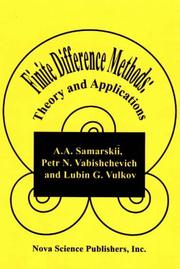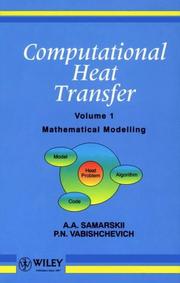| Listing 1 - 10 of 486 | << page >> |
Sort by
|
Book
ISBN: 9789176854273 Year: 2017 Publisher: Linkopings Universitet
Abstract | Keywords | Export | Availability | Bookmark
 Loading...
Loading...Choose an application
- Reference Manager
- EndNote
- RefWorks (Direct export to RefWorks)
This thesis by Viktor Linders focuses on error analysis in computational mathematics, particularly in the context of finite difference operators used in partial differential equations. It explores the SBP-SAT framework, which is designed to enhance accuracy and stability in numerical solutions by weakly imposing boundary conditions. The work addresses issues related to wave propagation and dispersion errors, proposing methods to construct SBP operators with minimal dispersion error. Additionally, it analyzes the accuracy of SBP operators near boundaries and introduces a transmission problem framework for coupling different dynamics in time. The thesis offers insights into improving numerical stability and accuracy for complex mathematical and physical problems, making it relevant for researchers and practitioners in computational mathematics and engineering.
Error analysis (Mathematics) --- Finite differences. --- Finite differences

ISBN: 1560726458 Year: 1999 Publisher: Commack, New York : Nova Science,
Abstract | Keywords | Export | Availability | Bookmark
 Loading...
Loading...Choose an application
- Reference Manager
- EndNote
- RefWorks (Direct export to RefWorks)
Book
ISBN: 9789176855959 Year: 2017 Publisher: Linkopings Universitet
Abstract | Keywords | Export | Availability | Bookmark
 Loading...
Loading...Choose an application
- Reference Manager
- EndNote
- RefWorks (Direct export to RefWorks)
This thesis by Hannes Frenander focuses on developing high-order accurate numerical schemes for hyperbolic problems using finite difference operators with the Simultaneous Approximation Terms (SAT) technique. The work introduces the Multiple Penalty Technique (MPT) to improve numerical scheme performance by incorporating additional data within computational domains. It also addresses the construction of Non-Reflecting Boundary Conditions (NRBC) using Summation-By-Parts (SBP) operators to ensure stability and accuracy in infinite physical domains. The research includes theoretical analysis and numerical experiments, highlighting error bounds for wave equations. Aimed at mathematicians and computational scientists, the thesis advances methodologies for modeling complex physical phenomena.
Numerical analysis. --- Finite differences. --- Numerical analysis --- Finite differences
Book
ISBN: 0080348718 Year: 1987 Publisher: Oxford : Pergamon press,
Abstract | Keywords | Export | Availability | Bookmark
 Loading...
Loading...Choose an application
- Reference Manager
- EndNote
- RefWorks (Direct export to RefWorks)
Finite differences. --- Underwater acoustics --- Measurement.

ISBN: 0471956597 0471956600 Year: 1995 Publisher: New York (N.Y.) : Wiley,
Abstract | Keywords | Export | Availability | Bookmark
 Loading...
Loading...Choose an application
- Reference Manager
- EndNote
- RefWorks (Direct export to RefWorks)
Finite differences. --- Heat --- Transmission --- Mathematics.
Book
Year: 1933 Publisher: London : MacMillan,
Abstract | Keywords | Export | Availability | Bookmark
 Loading...
Loading...Choose an application
- Reference Manager
- EndNote
- RefWorks (Direct export to RefWorks)
Interpolation. --- Difference equations. --- Finite differences.
Book
ISBN: 1608071774 9781608071777 9781608071760 1608071766 Year: 2011 Publisher: Boston : [Piscataqay, New Jersey] : Artech House, IEEE Xplore,
Abstract | Keywords | Export | Availability | Bookmark
 Loading...
Loading...Choose an application
- Reference Manager
- EndNote
- RefWorks (Direct export to RefWorks)
The finite-difference time-domain (FDTD) method has revolutionized antenna design and electromagnetics engineering. Here's a cutting-edge book that focuses on the performance optimization and engineering applications of FDTD simulation systems. Covering the latest developments in this area, this unique resource offer you expert advice on the FDTD method, hardware platforms, and network systems. Moreover the book offers guidance in distinguishing between the many different electromagnetics software packages on the market today. You also find a complete chapter dedicated to large multi-scale problem solving. This practical reference is supported with 250 illustrations, 128 equations, and 11 appendixes filled with helpful data processing techniques related to the FDTD method.
Book
ISBN: 868059315X Year: 1993
Abstract | Keywords | Export | Availability | Bookmark
 Loading...
Loading...Choose an application
- Reference Manager
- EndNote
- RefWorks (Direct export to RefWorks)
Book
ISBN: 0511626355 Year: 1996 Publisher: Cambridge : Cambridge University Press,
Abstract | Keywords | Export | Availability | Bookmark
 Loading...
Loading...Choose an application
- Reference Manager
- EndNote
- RefWorks (Direct export to RefWorks)
Partial differential equations arise in almost all areas of science, engineering, modeling, and forecasting. During the last two decades pseudospectral methods have emerged as successful alternatives to better known computational procedures, (e.g. finite difference and finite element methods of numerical solution), in several key application areas. These areas include computational fluid dynamics, wave motion, and weather forecasting. This book explains how, when and why this pseudospectral approach works. In order to make the subject accessible to students as well as researchers and engineers, the subject is presented using illustrations, examples, heuristic explanations, and algorithms rather than rigorous theoretical arguments. This book will be of interest to graduate students, scientists and engineers interested in applying pseudospectral methods to real problems.
Book
ISBN: 1139698931 1139861956 1139860879 1139236911 1139863029 1139868721 1139870874 1139865145 Year: 2014 Publisher: Cambridge : Cambridge University Press,
Abstract | Keywords | Export | Availability | Bookmark
 Loading...
Loading...Choose an application
- Reference Manager
- EndNote
- RefWorks (Direct export to RefWorks)
Among all the numerical methods in seismology, the finite-difference (FD) technique provides the best balance of accuracy and computational efficiency. This book offers a comprehensive introduction to FD and its applications to earthquake motion. Using a systematic tutorial approach, the book requires only undergraduate degree-level mathematics and provides a user-friendly explanation of the relevant theory. It explains FD schemes for solving wave equations and elastodynamic equations of motion in heterogeneous media, and provides an introduction to the rheology of viscoelastic and elastoplastic media. It also presents an advanced FD time-domain method for efficient numerical simulations of earthquake ground motion in realistic complex models of local surface sedimentary structures. Accompanied by a suite of online resources to help put the theory into practice, this is a vital resource for professionals and academic researchers using numerical seismological techniques, and graduate students in earthquake seismology, computational and numerical modelling, and applied mathematics.
| Listing 1 - 10 of 486 | << page >> |
Sort by
|

 Search
Search Feedback
Feedback About UniCat
About UniCat  Help
Help News
News